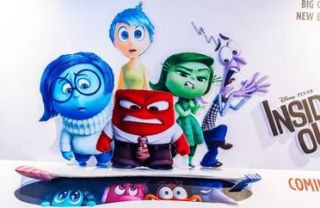Emotions
The Science of Emotions: Questions Raised by Inside Out 2
Where do complex emotions come from?
Posted July 10, 2024 Reviewed by Lybi Ma
Key points
- The film Inside Out 2 features new complex emotions bursting in on "basic" emotions.
- Research does not clearly answer the question about where complex emotions come from
- Complex emotions could grow out of basic emotions or emerge during development.
In the most recent Inside Out movie, the main character Riley enters puberty, and several new emotion characters enter the space. These include anxiety, envy, embarrassment, ennui, and spot appearances by nostalgia. The entry of these emotions in the film is chaotic. A wrecking ball that smashes through a window panel and the control panel that the emotion uses to alter Riley’s responses is updated with new buttons and capabilities. The new characters then emerge, to the shock of the emotion characters from the first movie (joy, disgust, sadness, anger, and fear). The scene poignantly captures the chaos adolescents often experience in their emotions, with often overwhelming new feelings seeming to appear out of nowhere. But the scene also raises an interesting question for emotion science (and people interested in emotions): where do complex emotions come from?

The short answer is: We don’t know. Some emotion theories argue that more complicated emotions (sometimes called “secondary emotions”) are built from more basic “primary” emotions. Most of the theories suggest this happens when complicated cognitions and often social awareness are paired through a learning process with existing basic emotions.
- Fear and anxiety are good examples of this. Fear is often considered a basic emotion that is present in infants and strongly associated with specific responses (physical arousal, avoidance, screams, and cries). Fear is a reaction to present danger. Anxiety is considered a response to threats that are not certain, often tied to thoughts about the past and future.
- In these theories, the basic response of fear becomes tied to people’s thoughts about uncertain threats. Thinking about the future and past is a relatively advanced cognitive ability. Anxiety would only emerge from fear at the point that people have that ability and learn to tie fear responses with those thoughts.
Another possibility from emotion theories is that more complicated emotions emerge as part of development. Similar to the way that hormones at puberty release changes in people’s physical bodies, it is possible that hormones or other processes at puberty release changes in people’s emotions.
- In the example of fear and anxiety, this would mean that the two emotions could differ in the responses associated with them. Anxiety would not “grow out of” fear responses. Instead, anxiety would emerge at the point that people develop the ability to think about uncertain threats.
The scene from Inside Out 2 is consistent with this second idea that emotions emerge as part of development. The new emotions suddenly show up. They do not gradually emerge from the other emotions. Interestingly, there is some evidence that supports this view in research studies. Although fear and anxiety overlap in many of the responses they create, there are instances where they are different. Fear decreases sensitivity to pain, for example, whereas anxiety increases sensitivity to pain. If you view emotions as functional, this makes sense. Being less sensitive to pain when you feel fear and are in the presence of real danger, such as a bear, could help you survive by continuing to run or fight if you are injured. Being more sensitive to pain when you feel anxiety and are imagining possible uncertain threats, such as possibly falling from a high cliff, could help keep you vigilant and able to respond quickly to any sign that the threat is becoming real.
Why does it matter? If “secondary” emotions are completely learned, there should be wide variation among people. Some people might learn to pair thoughts about uncertain threats with fear-anxiety, some might learn to pair thoughts about uncertain threats with other emotions, some might not have an emotion to uncertain threats at all, and some might have a unique emotional response unshared by other people. To address emotional distress, treatments would need to focus on learning processes and “re-learning” associations between thoughts about uncertain threats and responses.
If instead, emotions emerge at specific points in development, then less variation would be expected among people, and most people, most of the time, should respond with anxiety to thoughts about uncertain threats. If they do not, that could represent a possible mental health disorder. Treatments for responses that are too low, too high, or unusual would focus on changing people’s thoughts or their ability to control responses. In this approach, you cannot “unlearn” the connections between anxiety and thoughts about uncertain threats, but you can learn to control the way you think about threats or the way your body responds to those threats.
Inside Out 2 is a movie, but how we think about the question of where complex emotions come from has serious implications for how to conceptualize and treat emotional disorders.


